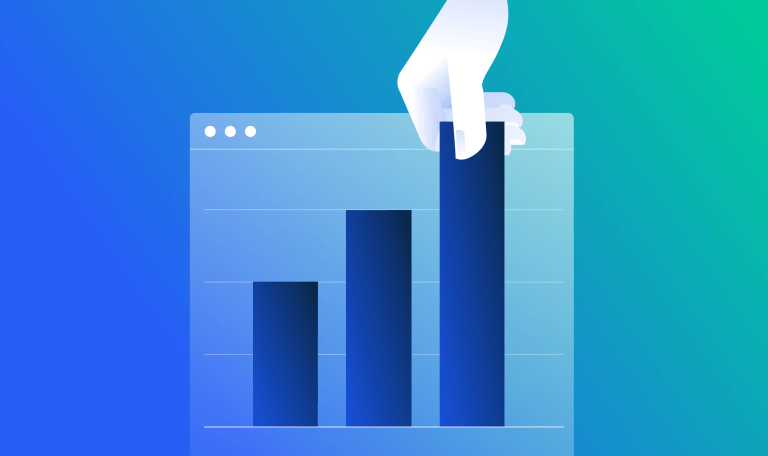Alternative Data for Hedge Funds: The Competitive Edge to Investing

The last five years have seen a tremendous paradigm shift in how hedge funds source and implement data into their investment methodology. With increasing competition to beat the market index and raise new assets, hedge funds are gaining a competitive edge with alternative data.
How hedge funds beat the market with alternative data
Hedge funds are trading traditional data for an alternative edge in their investment process. Alternative data sets deliver crucial insights to share prices and a near real-time understanding of a company’s digital success not typically covered by traditional data. Fund managers invest nearly $3 billion annually in alternative data sets, with yearly spending growing by 20-30%. From under $500 million in 2018, the alt data market will hit $100 billion by 2030.
One of the main reasons hedge funds lean toward alt data is because it fills an information void between earnings calls.
Hedge funds also use non-traditional data providers to corroborate their investment thesis. When a fund manager hypothesizes that a particular stock will outperform its competitors, corroborating data should support that thesis. How? By showing an upward spike in web searches to the company’s website, for example.
Additionally, new data could indicate a marked improvement in the company’s effectiveness at turning unique website visitors into paying customers. But what if it picks up on a sharp drop-off in a company’s consumer interest as compared to its competitors? Then a fund manager may need to look out for an earnings miss.
Similarweb’s alternative data can gauge overall market interest in a stock. That interest could reflect how popular the company is in both searches and purchases online. From the top-down perspective, consumer interest could be measured by the aggregation of overall macroeconomic factors. Leveraging snapshots of the economy and consumer behavior are areas where hedge funds rely on alternative data.
Top alternative data sets used by hedge funds
1. Web data
Every day, more of the global economy moves online, reflecting consumer and enterprise spending habits. How users interact with a company online benchmarked against its competitors provides insights into whether companies win or lose within a sector.
Conversion rate, for example, is an essential transaction data metric. Completely absent in SEC filings, conversion takes all foot traffic from unique visitors to a website and calculates what percentage of those visitors make a purchase. The most successful companies on the web, like Amazon and Walmart, typically generate conversion rates in the double digits.
2. Survey data
While traditional data is sourced from within a company, survey data gains information from the external market—clients, supplies, or competitors. Data obtained by surveying people outside the company is separate and likely independent from company-provided financial statements.
Based on surveys, the widely followed Confidence Board Consumer Confidence Survey echoes consumer sentiment factors, including corporate climate, optimism over volatility and potential future developments, consumer attitude, buying intentions, inflation expectations, stock prices, and interest rates. Hedge funds use this type of alt data to monitor current positions, identify opportunities, or assess risk management issues.
3. Weather data
In decades past, the federal government alone controlled weather data — essential in forecasting agriculture prices. Today, hedge funds that specialize in commodities routinely buy private independent weather data.
For example, satellite imagery is used in the investment decision-making process to help forecast total rainfall, affecting agriculture prices. Hedge funds can leverage satellite images and raw data on weather patterns to make a range of decisions related to agriculture prices as well as travel, tourism, and consumer spending.
How top hedge funds use alternative data
Let’s look at Uber. By any traditional metric, Uber should have a very weak share price. Uber stock pays zero dividends and, given negative operating cash flow – essentially a cash burn — it’s unlikely the company will pay any dividend for the foreseeable future.
Indeed, Uber has lost money in 11 of the previous 12 quarters. The first time it declared positive earnings for 2Q21, the stock price actually dipped.
Nonetheless, by market capitalization, Uber is worth over $75B. That’s the cash price. As Uber has zero earnings, no dividend, and negative cash flow, academic models using traditional data sources would likely assess the value of Uber stock at near zero. That’s the theoretical value.
With cash, you can pay bills — but you can’t buy anything with theoretical value.
In the real world, cash is king. Anything else is a matter of opinion.
Alternative data: what does it mean?
The concept of alternative data has been bandied about for years. Several vital attributes distinguish alternative data above and beyond traditional data.
- Insight into conversion, that all-important ability to generate revenue, is essential in estimating future growth potential. For example, the capabilities of a company’s technology platform to convert initial customer interest into actual sales are reflected in web analytics, like unique visitors and conversion rates.
- The types of data offered by alternative data vendors, such as website analytics, are generally forward-looking rather than historical.
- Alternative data providers that focus on website traffic can indicate the strength of the brand. Additionally, the amount of referral traffic can be used to measure a company’s affiliate strategy or degree of media coverage.
- Alternative data sets are far more costly to collect for institutional investors and hedge funds.
- Alternative data is used only by hedge funds and a handful of sophisticated investors within financial services, such as private equity funds and venture capital funds.
- Alternative data sources are highly challenging to source, dominating most originates outside a company and outside traditional financial markets.
Hedge funds use alternative data to value future expectations
Hedge funds and other investment firms use alt data over traditional data to value companies like Uber because of highly bullish stock market expectations of future growth.
In Uber’s case, the tech giant has dominated U.S. restaurant home delivery and is now taking on freight logistics. Uber’s web traffic of some 80 million monthly visits dominates the entire ground transport sector. As such, markets are focused on Uber’s high future growth expectations and are relatively unconcerned with its history.
When it comes to evaluating market sentiment about a stock’s growth potential, alternative data is king.
Take a company’s ability to turn online visits into sales and its brand equity. Success can be estimated by unique website visits, converted visits, and its conversion rate—all web metrics strongly correlated with future growth, revenue potential, and effectiveness at retaining repeat customers.
Hedge funds know the economy moved online in real-time
The internet has ushered the global economy away from making one-off purchases from brick-and-mortar locations, but the transformation is far from complete.
Every year, more businesses move online, rely on the cloud, and connect with their clients (B2B and B2C) via the internet to generate revenues, build their brand, and expand in markets.
Consider this:
- Retailers sold to 1.79 billion online shoppers in 2020.
- According to the Internet Association, the internet sector accounts for $2.1 trillion, or more than 10% of U.S. GDP.
- Global eCommerce sales should hit $4.8 trillion in 2021.
- 64% of small businesses in the U.S. have a website to help them generate orders or begin the customer journey toward purchase.
- 88% of consumers research online before making a purchase, whether online or in-store.
- 57% of users wouldn’t recommend a business with a poor user experience after visiting a website via a mobile device.
Additionally, Broadcast TV audiences, where advertisers have in past decades traditionally spent billions, are shriveling while online visitors skyrocket. According to Nielsen, the time 18-34-year-olds spent watching traditional TV recently dipped 23.4% from 2020. The same demographic spent a whopping 250% as much time using web-connected apps on smartphones than watching traditional TV.
In 2000, the most valuable companies in the U.S. were General Electric, Exxon, Pfizer, and Citigroup. Now, Apple, Facebook, Microsoft, Amazon, and Alphabet (Google) take the cake. Traditional industries have been entirely rebuilt from scratch as the global economy continues to shift online.
Hedge funds use alternative data to target alpha, not beta
To fully understand the internet-based global economy, investment firms must leverage new web analytic tools to gain a competitive edge in the market.
Investment in the right internet-based companies is precisely the rocket fuel that drives buy-side firms to outperform the market.
The hedge fund industry implements a methodology around alternative data inputs and data science to analyze in-depth the digital performance of any company with a web presence.
Weeks before the earnings release, portfolio managers, analysts, and traders scrutinize alternative web data to assess, validate, and monitor investment decisions. By doing this, they’re able to see what their competitors cannot.
Merely tracking the market and capturing beta can be done by low-cost index funds. No investment firm in the financial services industry can grow in the long term on a business model based on delivering beta, the market index, alone.
“The world is becoming more and more digitized,” according to Jack Inglis, Chief Executive Officer of the Alternative Investment Management Association (AIMA). “The types of information hedge fund managers use to research ideas or improve their understanding of portfolio positions will also expand.”
Life moves fast, but the internet moves faster. Hedge funds can’t afford to wait until the end of a quarter to learn about a company’s digital performance.
Hedge funds march ahead with alternative data
According to the Deloitte Center for Financial Research, alternative data will likely transform the entire asset management industry—from hedge funds to long-only, to venture capital firms and private equity managers.
Whether that big data comes from credit card transactions, satellite imagery, geolocation data sources, real estate sites, or social media, it can all be aggregated to deliver a competitive edge.
Start making better investment decisions today
Contact us to learn more about alternative data. One of our data experts will quickly walk you through our platform — including our Investment API, which empowers you with vast amounts of data just a mouse click away.
FAQ
What is alternative data?
Alternative data is a broad term that refers to non-traditional data sources used by investors to gain insights and make investment decisions. It can include things like social media sentiment, satellite imagery, website traffic, credit card transaction data, and more.
Why do hedge funds use alternative data?
Hedge funds use alternative data to gain an edge in the markets by identifying trends and patterns that traditional data sources may not reveal. By analyzing alternative data, they can gain unique insights into consumer behavior, industry trends, and more.
What are some examples of alternative data that hedge funds use?
Hedge funds use a wide variety of alternative data sources, including satellite imagery to track retail parking lots, social media sentiment to gauge consumer opinion, credit card transaction data to track spending patterns, and more.
How do hedge funds analyze alternative data?
Hedge funds typically use sophisticated data analytics tools and algorithms to analyze large volumes of data from a variety of sources. They may also use machine learning and artificial intelligence to identify patterns and insights.
How can investors access alternative data?
Investors can access alternative data from a variety of sources, including data providers and specialized analytics firms. However, it is important to note that alternative data can be expensive and may require specialized expertise to analyze effectively.
Invest using the most insightful asset research
Leverage data used by 5,000+ companies to improve your strategy

















